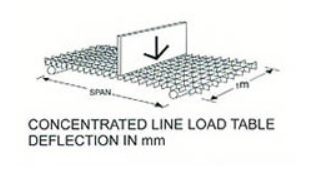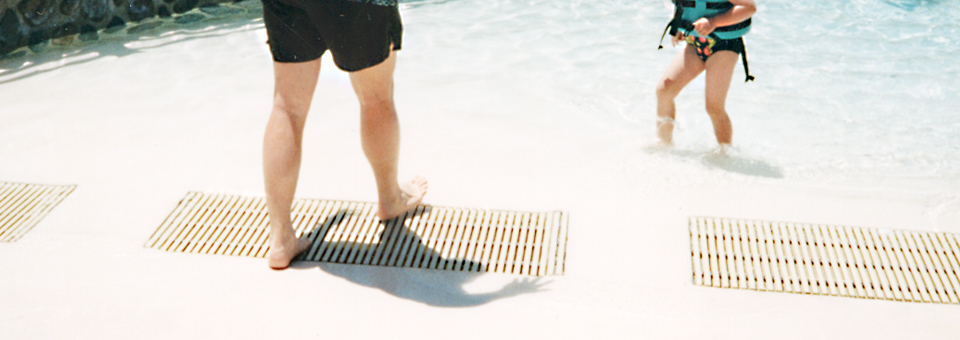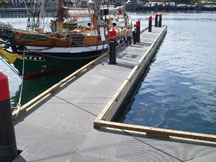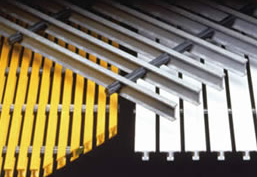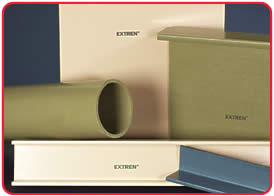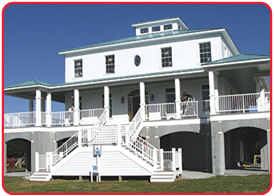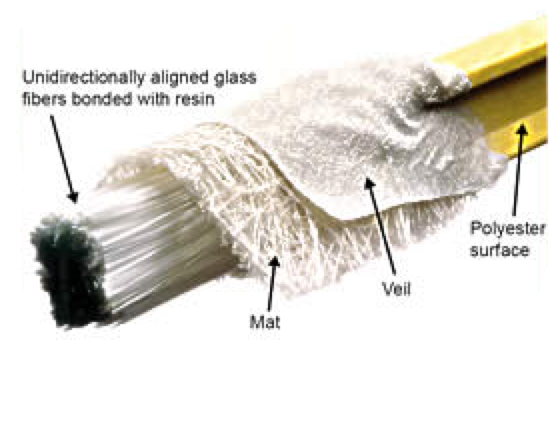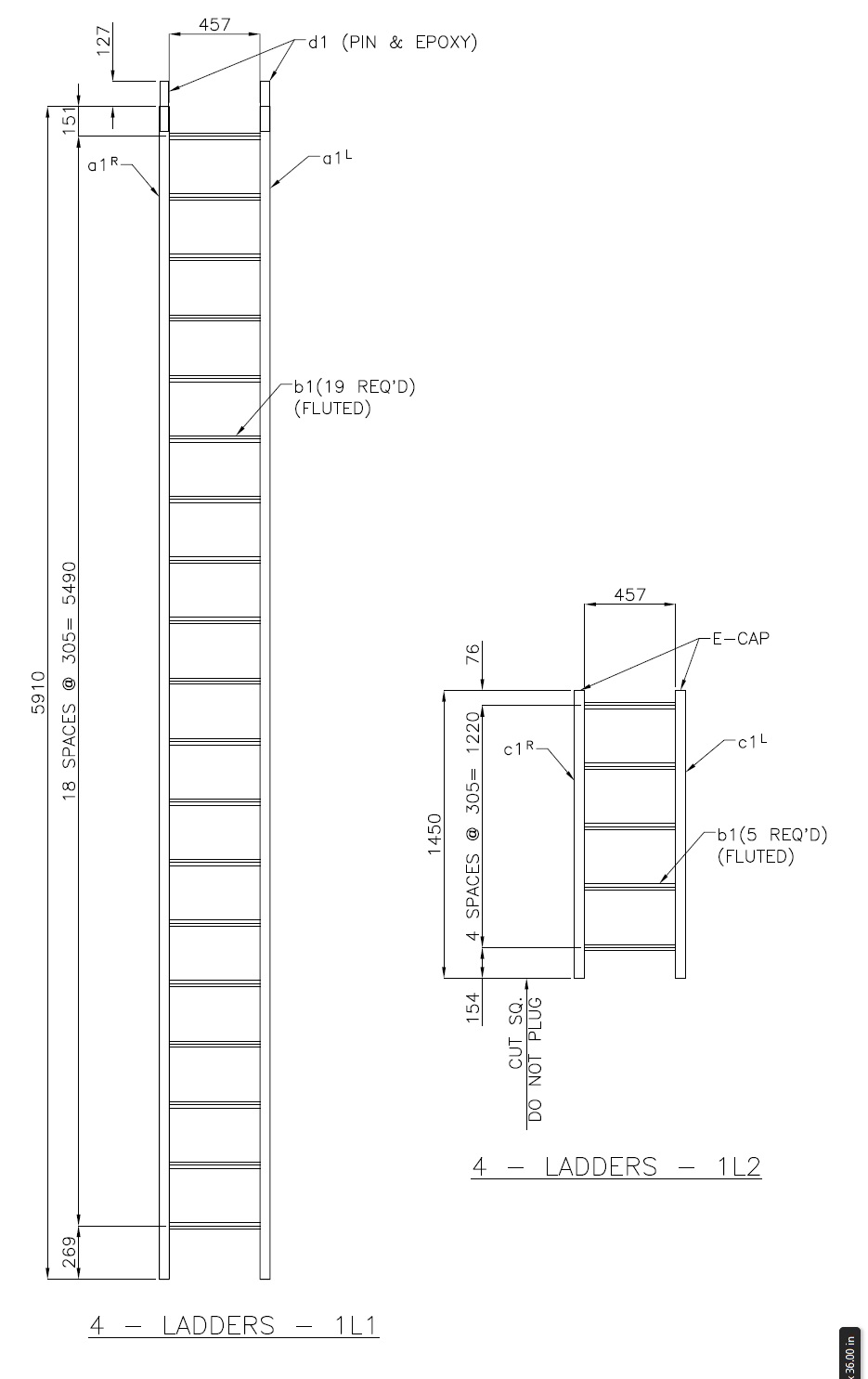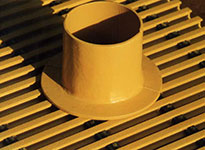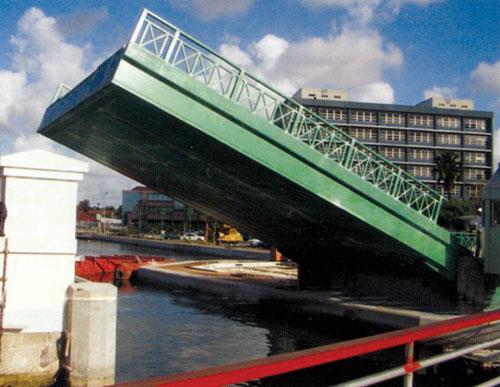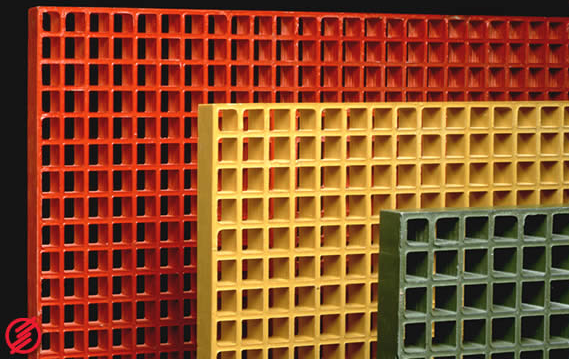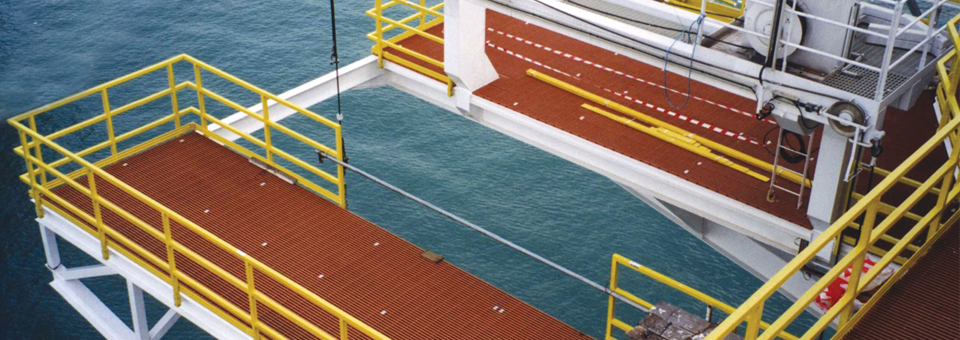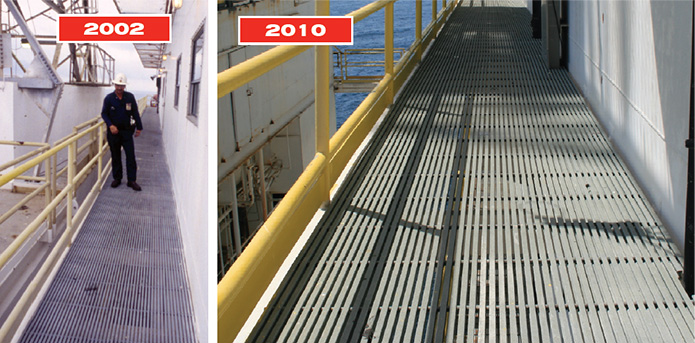News
Grating and “Deflection”
We had a customer inquiry a few weeks ago where an engineer had viewed our load tables for our FRP (fiberglass reinforced plastic) grating brochures and told us they were incomplete. The customer was designing an application with a span of about 7 feet and wanted load table sheets for that span. The problem was, there are no load tables for such a span! FRP grating is not meant for spans in excess of 54″ and we had to explain to the customer that he would need to revise his design. The issue comes down to a term: “deflection”. Deflection can also be called “bounce” because that’s what it literally is when we discuss deflection in regards to FRP grating. FRP will deflect much more than metal grating will and this is perhaps not widely known. The problem is that too much deflection makes it unsafe for people to walk on, it feels uncomfortable and balance can be lost leading to falls. Instead of trying to make the grating fit your design, you should take deflection seriously and reduce the span. It will create a sturdier, safer platform.
For our new load tables click here.
Redco Pool Grating Pultrusions
One of the more popular applications for Redco pultruded FRP (fiberglass reinforced plastic) grating is for use in swimming pools, around the edges or anywhere excess water drains. In these cases the grating is usually gritted on top, fully UV coated, with an “I” profile chosen (I-1800 is one of the more common specs). The reason for the material’s selection is obvious when you consider the properties of pultruded grating: it will never rot, rust, conduct electricity or support microbial life. It is lightweight, easy to install and is also very strong. Installation is easy and once the grating is in place it will require no maintenance except for cleaning. Of course, one of the most important advantages of the FRP is that its resin will resist constant exposure to chlorine and other sterilizing or cleaning chemicals.
If you have a drawing where pultruded FRP grating for a swimming pool application is specified, please email it to us for quotation (note: we cannot help engineer your pool grating, we need a pre-engineered spec and drawings to quote).
Solution Spotlight: Conveyor Drip Pans
Conveyor drip pans in coal-fired power plants are located under the conveyors bringing coal to the power station. Each week, a worker needs to climb into these pans to clean out (wash down) the coal dust to reduce the chance of spontaneous combustion or structural fatigue. Fiberglass reinforced plastics (FRP) were considered along with traditional 3/16″ stainless steel plate when a coal fired power station in the U.S. needed new drip pans back in 1993. The criteria was for a low-maintenance, easy-to-install option which would still permit a worker to stand in the pan and perform maintenance. The material also had to be strong enough to handle the abrasion of being shoveled and cleaned countless times over its lifespan. Ultimately, FRP was chosen for its low-weight, ease of handling, and competitive price.
For more information on Redco FRP products please contact us.
Build A Dock With Mini-Mesh
FRP (fiberglass reinforced plastic) mini-mesh is one of our most popular types of grating. The mini-mesh gets its name because the holes in the grating are small ( 3/4″ x 3/4″) and this prevents most small objects such as keys from falling through. For this reason, mini-mesh is very popular in marine applications. The grating will not rot, is UV-resistant, and has a grit surface to make it anti-slip. The grating is easy to install and “foolproof” in that it doesn’t matter which direction it’s installed in (unlike pultruded grating). There are two ways to install the grating: the simplest way is to build a frame for it to sit in and then use grating-specific hardware known as “m-clips” to affix the grating to the lip that supports it. Intermediate supports are best every 18″ if possible. You could also use the grating as the dock itself, in this case you will still want supports every 18″-24″. The standard color of mini-mesh is grey but other colors are sometimes available, most frequently black.
The cost of the dock will vary on how many sheets of mini-mesh you require, the amount of m-clips, and freight costs. The FRP components for a typical dock for private use would likely end up approximately $4000.00-$6000.00 USD including M-clips, taxes, and freight to land the material at your location in North America. While this may be more expensive than wood you need to consider the lifecycle benefits of FRP, which are far better than wood in every respect: much longer life, no rot, grit surface, etc. It’s just a better material overall. So for your new or refurbished dock, why not consider mini-mesh?
For your questions on mini mesh or our other plastic products please contact us today.
Grating & Load
For those not already accustomed to fiberglass reinforced plastic (FRP) grating one of the most common questions we are asked is how much load the grating can take and what the span needs to be. Obviously there is no “one size fits all” answer to this question. The good news is that we have some excellent load tables for the most popular grating formats. The load tables give span distances and safety factors for point loads from 100-500lbs. One of the most important factors with fiberglass grating, if not the most important, is deflection. Grating will deflect or “flex” more than metal grating and this could lead to a situation where if the span is too wide, walking on the grating could be uncomfortable and lead to someone losing their balance.
There are also differences between the grating types: Redco pultruded grating can handle more load over wider spans than regular molded grating. This is because the designs are completely different. While molded grating is “dummy proof” and can be placed in any direction the pultruded grating on the other hand uses a bearing bar system. Bearing bars must be orientated correctly; however, they’re larger and stronger than their molded counterparts and thus allow for more load over a wider span. Pultruded grating is the type most people are less familiar with but we do have information available. For Strongwell’s pultruded grating brochure with load tables click here.
Redco EXTREN – Answers To Your FAQS
Fiberglass reinforced plastic (FRP) composites have been used in a wide variety of industries for decades. But knowledge of the material and its properties are not yet common knowledge, so we’ve assembled some answers to frequently asked questions that come up regarding the material.
1.) What is EXTREN?
This is the most general question but it alludes to the three grades of Redco EXTREN available. EXTREN is a series of plate, tube, and shapes of mechanical-grade FRP and is a made of glass rovings and mat bound by a plastic resin. There are three basic grades available:
EXTREN 500: Polyester resin, non-fire retardant, olive-green in color.
EXTREN 525: Polyester resin, fire retardant, grey in color.
EXTREN 625: Vinyl ester resin, fire retardant, beige in color (for applications with aggressive corrosion concerns)
All three grades have a UV-inhibitor to make the EXTREN suitable for outdoor use.
2.) How much more does EXTREN cost than traditional materials such as steel, aluminum or wood?
This answer can only be made by splitting the question into two parts. The upfront cost of EXTREN is more than all of the comparable materials, perhaps between 2-3 times more, depending on the product. However, the product was never meant to compete with traditional materials on upfront cost.
In many applications EXTREN has a vastly lower lifecycle cost, this is because EXTREN will last much longer before replacement, require much less maintenance, be much easier to install, suffer much less corrosion damage, or any combination of those properties and others not listed here. Frankly, EXTREN would not have persisted as a viable product for so many decades if it did not offer customers substantial advantages and cost-savings over the long term!
3.) What is the operational temperature range of EXTREN?
Series 500-525 EXTREN can handle operational temperatures up to 150 degrees Fahrenheit and the 625 series can handle up to 200 degrees. All three product lines are excellent in cold applications and can operate down to -60 degrees Fahrenheit.
4.) How long will EXTREN last outside?
This is impossible to say. It depends on location, sun exposure, and weather patterns: there is no way to simply calculate this, nor is the material guaranteed for a specific amount of time. What will occur first is a discoloring of the EXTREN but this does not affect physical strength. If extra UV-protection is desired, polyurethane or epoxy based paints will help.
5.) What is the fire retardancy of EXTREN?
Series 525 and 625 have a 94 V-O flame spread rating. Series 500 is not fire retardant.
6.) What MIL-spec does EXTREN meet?
There are several specs that reference FRP:
If you have further questions about Redco EXTREN or would like additional assistance please contact us.
Engineering Support
It’s understandable that, until FRP (fiberglass reinforced plastic) materials are as well known as traditional material such as metal or wood, engineering questions will come up. There are two ways we can get you the information you require. Firstly, if you have engineers on staff or otherwise involved in the project we can get you access to the Strongwell Design Manual. This is a very complete document that will supply you with everything an engineer will need to design an FRP application. This document is available digitally but a printed copy can be supplied on request. The other alternative is to have Strongwell’s own engineers to design the application.
If this is to be the case, we must be made aware of it at the beginning of the inquiry process. This does not mean; however, that Redco FRP applications can be supplied with a simple “I need a 20′ x 20′ platform that is 9′ high”. We will still require the customer to furnish specific information such as temperatures, chemical exposure, flame-retardancy requirements, load requirements, etc. The engineers need this information to develop an appropriate solution. Engineers are personally responsible for any design they make and therefore will not put their stamp on a project they are not confidant will be safe and successful.
If you are interested in some assistance with an FRP project use our contact form here. You can attach any drawing you may have to that form. Please be as detailed as you can and include your approximate budget if known.
Angles, Channel and Tube
Amongst the Redco fiberglass reinforced plastic (FRP) line products such as custom ladder components or grating come first to mind. These products have highly visible applications in many industries and are not easily missed by employees or onlookers. However, FRP components solve pain points for customers every day using simple profiles and shapes. For example, FRP angle comes in all three EXTREN resin types (500, 525, and 625) in dimensions from 1″ x 1/8″ thick to 6″ x 1/2″ thick. Many of these profiles are stocked at Strongwell. FRP channel is another product many potential users might not even know exists but, in fact, channel is available from 1.5″ x 1″ x 3/16″ thick to a giant 24″ x 3″ x .260″ profile. What other FRP profiles are available? Round, square and rectangular tubes between 1-9″ outer diameter and up to a 7/16″ wall (depends on the product). Know that rectangular and round bar stock are also available from 1/4 to 2″ OD (depends on profile).
What applications do these have use in? Anything you can imagine practically. The angle performs particularly well as edge protection, for example, bolted into concrete as it will not corrode or rust like metals would and is more flexible, shrugging off impact that would permanently dent metal angle. Larger rectangular tube has been used in architectural applications before, such as a “hurricane-proof” home on the U.S. Southeast (pictured). Round tube has been used as tool handles. Some of these profiles are not fire retardant or colored the same as other EXTREN profiles, so please be sure to ask. Custom coloring and fire-retardancy can be added on request.
For assistance with your application or for your questions on availability of any of these profiles, contact us today!
When Is FRP Right For Your Application?
Fiberglass reinforced plastic (FRP) outperforms traditional structural materials (wood and metal) in a wide variety of applications. In many cases, the only draw back to choosing FRP is initial cost as the material does cost more than wood or metal and we don’t hide that. However, as FRP shows its advantages over its long lifespan the lower lifecycle cost of the product becomes clear. We say if an application requires one of the following FRP advantages then it is a “good” application for FRP. Two advantages means an “excellent” opportunity and three or more relevant advantages means FRP is an outstanding choice!
- Corrosion-resistant
- Electrically non-conductive
- No rot
- Will not be attacked by microbial life
- Easy to install
- No rust
- Excellent cold weather properties
- Flame retardant (certain grades)
If you have questions or need help with your FRP project please contact us.
Case Study: NSF 61 Ladder System
One of our sales people had got in touch with a municipal water treatment plant manager in the Canadian province of Manitoba back in 2013. The manager was not aware of fiberglass reinforced plastic (FRP) but did have a pain point: his metal ladders were rusting and this rust was getting into the potable water tanks. We had a solution: FRP ladders will never rust and can easily be manufactured to be NSF 61 safe for potable water applications. Certifications can be supplied on request. In this case, the customer had specifications for a metal ladder that would be suitable for his application. We took those drawings and in conjunction with our engineering partners, developed drawings for a custom ladder system. This system had to be designed to allow workers to have free movement in a confined space, and that was not a problem, but it did mean that a cage was not required.
Drawings were supplied to the customer after a PO was received. We offer drawings with two revisions as part of the purchase order. The first drawings were sufficient and fabrication commenced. The ladders were delivered ahead of schedule and the customer was more than satisfied.
For assistance with your FRP applications please contact us.

